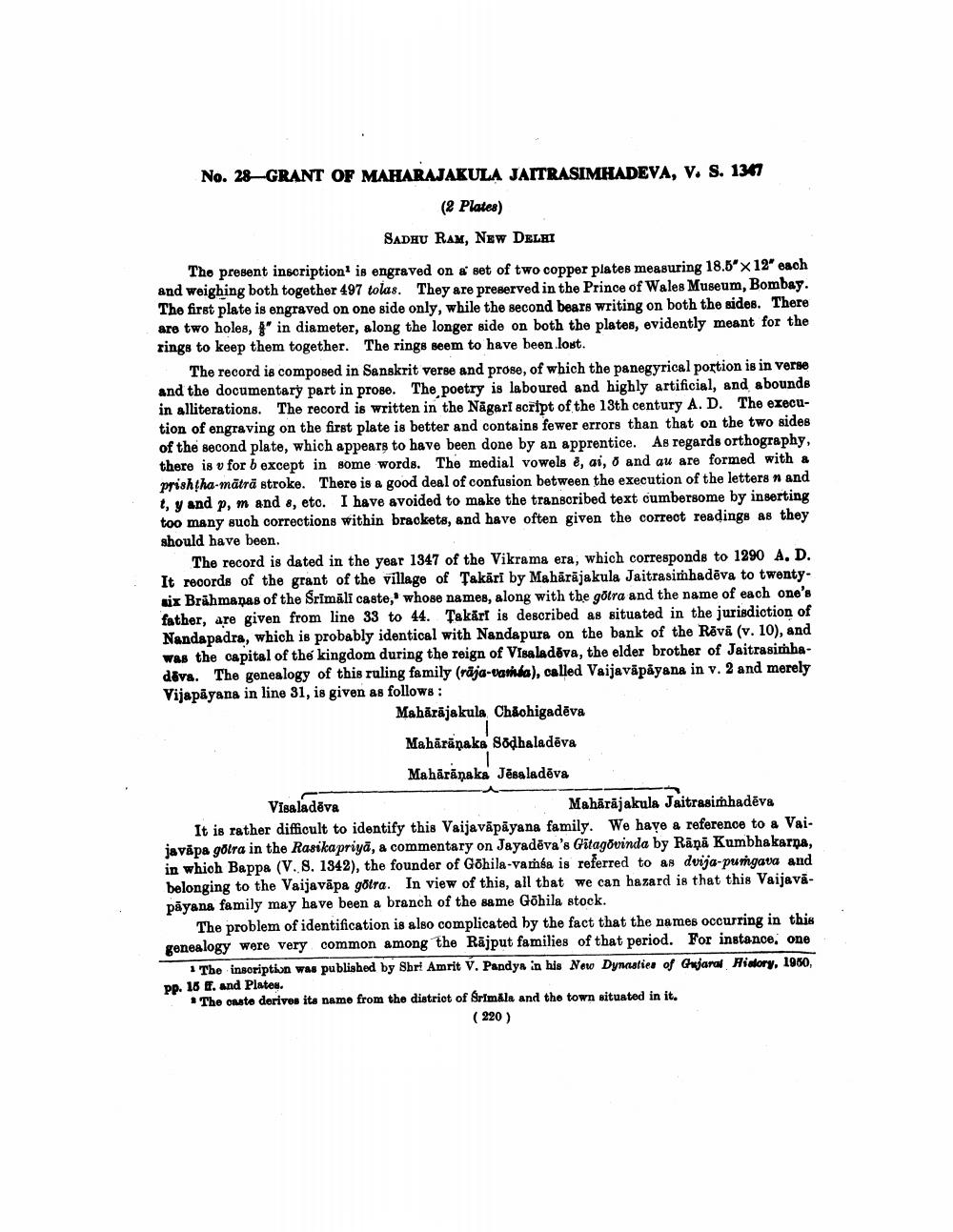________________
No. 28-GRANT OF MAHARAJAKULA JAITRASIMHADEVA, V. S. 1347
(2 Plates)
SADHU RAM, NEW DELHI
The present inscription is engraved on a set of two copper plates measuring 18.5"x12" each and weighing both together 497 tolas. They are preserved in the Prince of Wales Museum, Bombay. The first plate is engraved on one side only, while the second bears writing on both the sides. There are two holes, " in diameter, along the longer side on both the plates, evidently meant for the rings to keep them together. The rings seem to have been lost.
The record is composed in Sanskrit verse and prose, of which the panegyrical portion is in verse and the documentary part in prose. The poetry is laboured and highly artificial, and abounds in alliterations. The record is written in the Nagari script of the 13th century A. D. The execution of engraving on the first plate is better and contains fewer errors than that on the two sides of the second plate, which appears to have been done by an apprentice. As regards orthography, there is v for b except in some words. The medial vowels è, ai, ō and au are formed with a prishtha-mātrā stroke. There is a good deal of confusion between the execution of the letters n and t, y and p, m and 8, etc. I have avoided to make the transcribed text cumbersome by inserting too many such corrections within brackets, and have often given the correct readings as they should have been.
The record is dated in the year 1347 of the Vikrama era, which corresponds to 1290 A. D. It records of the grant of the village of Takari by Mahārājakula Jaitrasimhadeva to twentysix Brahmanas of the Srimali caste, whose names, along with the gōtra and the name of each one's father, are given from line 33 to 44. Takart is described as situated in the jurisdiction of Nandapadra, which is probably identical with Nandapura on the bank of the Revä (v. 10), and was the capital of the kingdom during the reign of Visaladeva, the elder brother of Jaitrasimhadeva. The genealogy of this ruling family (raja-vaméa), called Vaijavapayana in v. 2 and merely Vijapayana in line 31, is given as follows:
Maharajakula Chachigadeva
I Maharanaka Södhaladeva
1
Maharanaka Jesaladeva
Visaladeva
Mahārājakula Jaitrasimhadeva
It is rather difficult to identify this Vaijavapayana family. We have a reference to a Vaijavapa götra in the Rasikapriya, a commentary on Jayadeva's Gitagovinda by Rāņa Kumbhakarna, in which Bappa (V. S. 1342), the founder of Göhila-vamsa is referred to as dvija-pumgava and belonging to the Vaijavapa götra. In view of this, all that we can hazard is that this Vaijavapayana family may have been a branch of the same Gōhila stock.
The problem of identification is also complicated by the fact that the names occurring in this genealogy were very common among the Rajput families of that period. For instance, one
1 The inscription was published by Shri Amrit V. Pandya in his New Dynasties of Gujarat History, 1950, pp. 15 . and Plates.
The caste derives its name from the district of Srimala and the town situated in it.
(220)




